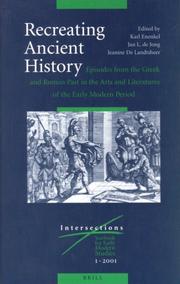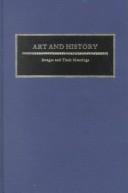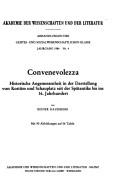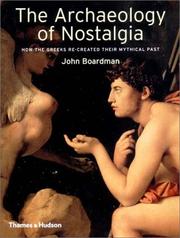| Listing 1 - 10 of 37 | << page >> |
Sort by
|

ISBN: 9789004120518 9789004475601 Year: 2001 Publisher: Leiden : E.J. Brill,
Abstract | Keywords | Export | Availability | Bookmark
 Loading...
Loading...Choose an application
- Reference Manager
- EndNote
- RefWorks (Direct export to RefWorks)
This volume deals with the question: how did scholars and artists in the early modern period represent, or rather, recreate (Greek and Roman) history? It appears that ancient history was not just studied so as to reconstruct the past, it was used as a way of understanding and legitimizing the present. Sixteen authors from various disciplines have studied the works of scholars and artists in different media so as to reveal how they used ancient history as a rich field of raw material, that could be used, recycled and adapted to new needs and purposes. The studies in this volume are important for historians of the early modern period from all disciplines, and for all those interested in the reception of classical antiquity. Contributors include: Maria Berbera, Jan Bloemendal, Anton Boschloo, Jeanine De Landtsheer, Jan L. de Jong, Karl Enenkel, Marc Laureys, Olga van Marion, Alicia Montoya, Mark Morford, Bettina Noak, Sjaak Onderdelinden, Paul Smith, Wilfried Stroh, Francesca Terrenato, Arnoud Visser, and Bart Westerweel. This publication has also been published in paperback, please click here for details.
Civilization, Classical, in art --- History in art --- Physician, Contemporary --- Historical art --- Art and history
Book
ISBN: 8024630281 9788024630281 9788024630281 Year: 2015 Publisher: Prague Charles University in Prague, Karolinum Press
Abstract | Keywords | Export | Availability | Bookmark
 Loading...
Loading...Choose an application
- Reference Manager
- EndNote
- RefWorks (Direct export to RefWorks)
Art --- Art and history. --- History in art. --- Historical art --- Art and history --- History and art --- History --- History in art --- Historiography.
Book
ISBN: 0715376861 Year: 1980 Publisher: Newton Abbot : David and Charles,
Abstract | Keywords | Export | Availability | Bookmark
 Loading...
Loading...Choose an application
- Reference Manager
- EndNote
- RefWorks (Direct export to RefWorks)
History in art. --- Tapestry --- Textile industry --- History. --- 745.522 --- Wandtapijten --- Tapijtkunst. Tapisserie. Gobelins --- 745.522 Tapijtkunst. Tapisserie. Gobelins --- History in art --- Historical art --- Art and history --- History
Book
ISBN: 9780520285279 0520285271 0520285271 Year: 2015 Publisher: Oakland University of California Press
Abstract | Keywords | Export | Availability | Bookmark
 Loading...
Loading...Choose an application
- Reference Manager
- EndNote
- RefWorks (Direct export to RefWorks)
"The compulsion to dwell on history--on how it is recorded, stored, saved, forgotten, narrated, lost, remembered, and made public--has been at the heart of artists' engagement with the photographic medium since the late 1960s. Uncertain Histories considers some of that work, ranging from installations that incorporate vast numbers of personal and vernacular photographs by Christian Boltanski, Dinh Q. Lê, and Gerhard Richter to confrontations with absence in the work of Joel Sternfeld and Ken Gonzales-Day. Projects such as these revolve around a photographic paradox that hinges equally on knowing and not knowing, on definitive proof coupled with uncertainty, on abundance of imagery being met squarely with its own inadequacy. Photography is seen as a fundamentally ambiguous medium that can be evocative of the historical past while at the same time limited in the stories it can convey. Rather than proclaiming definitively what photography is, the work discussed here posits photographs as objects always held in suspension, perpetually oscillating in their ability to tell history. Yet this ultimately leads to a new kind of knowledge production: uncertainty is not a dead end but a generative space for the viewer's engagement with the construction of history"--Provided by publisher.
Photographic criticism --- Photography, Artistic --- Art and history --- History in art --- Historical art --- History and art --- History --- Artistic photography --- Photography --- Photography, Pictorial --- Pictorial photography --- Art --- Photography criticism --- Criticism --- Aesthetics
Book
ISBN: 1009091808 100909548X 1009089404 1009089935 Year: 2022 Publisher: Cambridge : Cambridge University Press,
Abstract | Keywords | Export | Availability | Bookmark
 Loading...
Loading...Choose an application
- Reference Manager
- EndNote
- RefWorks (Direct export to RefWorks)
William Molyneux's question to John Locke about whether a blind man restored to sight could name the difference between a cube and a sphere without touching them shaped fundamental conflicts in philosophy, theology and science between empirical and idealist answers that are radically alien to current ways of seeing and feeling but were born of colonizing ambitions whose devastating genocidal and ecocidal consequences intensify today. This Element demonstrates how landscape paintings of unfamiliar terrains required historical and geological subject matter to supply tactile associations for empirical recognition of space, whereas idealism conferred unmediated but no less coercive sensory access. Close visual and verbal analysis using photographs of pictorial sites trace vividly different responses to the question, from those of William Hazlitt and John Ruskin in Britain to those of nineteenth-century authors and artists in the United States and Australia, including Ralph Waldo Emerson, Thomas Cole, William Haseltine, Fitz Henry Lane and Eugene von Guérard.
Landscape painting. --- Landscape painting --- Composition (Art) --- History in art. --- Geology in art. --- Appreciation. --- Historical art --- Art and history --- Art --- Proportion (Art) --- Painting --- Composition
Book
ISBN: 2852990024 9782852990029 Year: 1987 Publisher: Paris Mayer
Abstract | Keywords | Export | Availability | Bookmark
 Loading...
Loading...Choose an application
- Reference Manager
- EndNote
- RefWorks (Direct export to RefWorks)
Painting, French --- Mythology, Classical, in art --- Academic art, French --- History in art --- -Academic art, French --- -French academic art --- French painting --- Paintings, French --- Groupe Finistère (Group of artists) --- Historical art --- Art and history --- -History in art --- -Historical art --- French academic art --- Painting, Modern --- Painting, French - 19th century --- Academic art, French - 19th century

ISBN: 0521340187 0521335698 Year: 1988 Publisher: Cambridge
Abstract | Keywords | Export | Availability | Bookmark
 Loading...
Loading...Choose an application
- Reference Manager
- EndNote
- RefWorks (Direct export to RefWorks)
Art --- History as a science --- History in art. --- Art and history. --- 930.2 --- Methoden en technieken van de geschiedwetenschap --- 930.2 Methoden en technieken van de geschiedwetenschap --- Art and history --- History in art --- Historical art --- History and art --- History

ISBN: 3515039937 Year: 1984 Volume: vol 1984, 4 Publisher: Wiesbaden Steiner
Abstract | Keywords | Export | Availability | Bookmark
 Loading...
Loading...Choose an application
- Reference Manager
- EndNote
- RefWorks (Direct export to RefWorks)
Art, European --- -History in art --- Clothing and dress in art --- Costume in art --- Historical art --- Art and history --- Art, Modern --- European art --- Nouveaux réalistes (Group of artists) --- Zaj (Group of artists) --- Themes, motives --- History in art

ISBN: 0500051151 9780500051153 Year: 2002 Publisher: London ; New York, NY : Thames & Hudson,
Abstract | Keywords | Export | Availability | Bookmark
 Loading...
Loading...Choose an application
- Reference Manager
- EndNote
- RefWorks (Direct export to RefWorks)
Art and history --- History in art. --- Myth in art --- Art et histoire --- Histoire dans l'art --- Mythe dans l'art --- Art, Ancient --- Myth in art. --- History in art --- Historical art --- History and art --- History
Book
ISBN: 9780253006783 0253006783 Year: 2013 Publisher: Bloomington Indiana University Press
Abstract | Keywords | Export | Availability | Bookmark
 Loading...
Loading...Choose an application
- Reference Manager
- EndNote
- RefWorks (Direct export to RefWorks)
| Listing 1 - 10 of 37 | << page >> |
Sort by
|

 Search
Search Feedback
Feedback About UniCat
About UniCat  Help
Help News
News